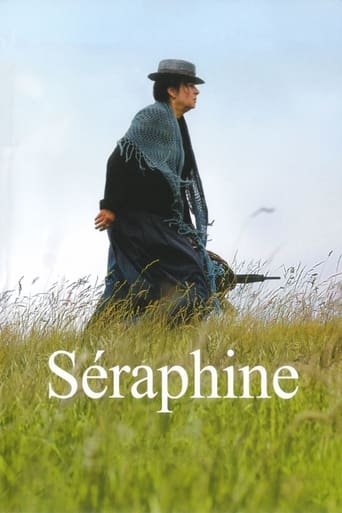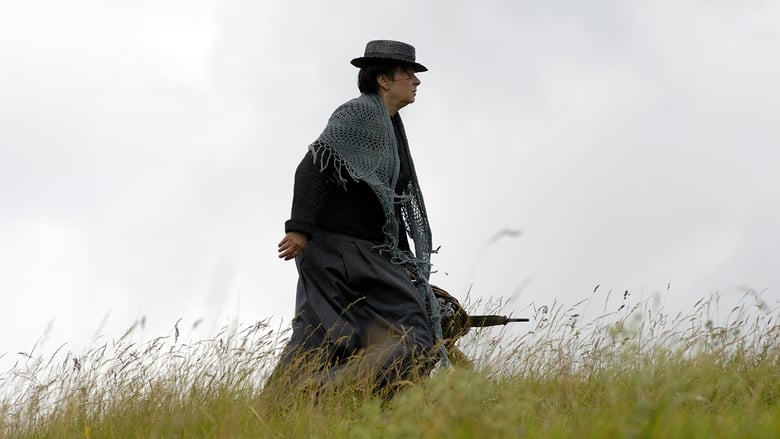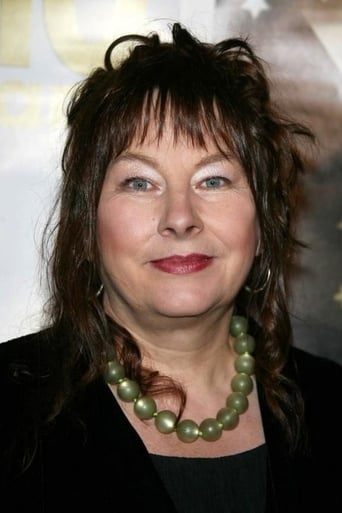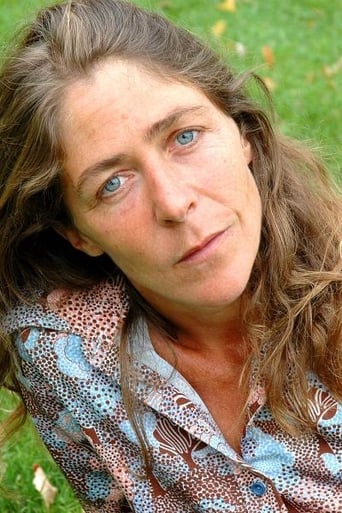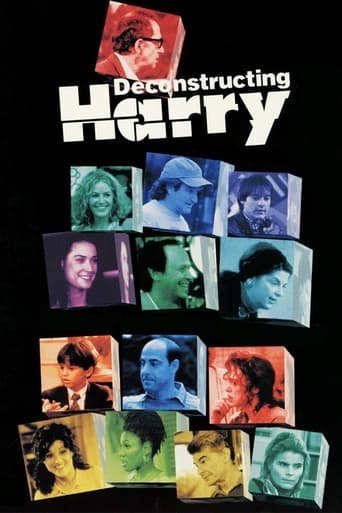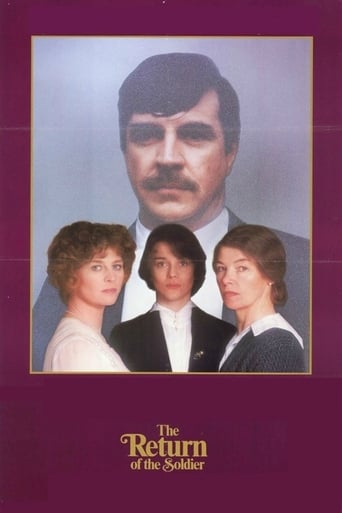Séraphine (2008)
The tragic story of French naïve painter Séraphine Louis aka Séraphine de Senlis (1864-1942), a humble servant who becomes a gifted self-taught painter. Discovered by prominent critic and collector William Uhde, she came to prominence between the wars grouped with other naïve painters like Henri Rouseau only to descend into madness and obscurity with the onset of Great Depression and World War II.
Watch Trailer
Cast


Similar titles
Reviews
Simply A Masterpiece
It's an amazing and heartbreaking story.
The acting is good, and the firecracker script has some excellent ideas.
There are moments in this movie where the great movie it could've been peek out... They're fleeting, here, but they're worth savoring, and they happen often enough to make it worth your while.
We absolutely loved every single minute of this film. It is a quiet, sweet story, and a true one. Now we want to go and visit the museum where her paintings are exhibited!
Most artists' lives are marked with excessive obsessions about what they are trying to accomplish. Some go to extremes as they are consumed with a passion about their work that eventually serve to render them into lunatics because of the demands they impose on themselves and on the work they are trying to create. Such is the case with Seraphine Louis, a poor woman from rural Senlis, in the Oise department of France.The life of Seraphine is at the center of a film that tries to understand a complex life that only brought her sadness and heartaches, and conspired to land her in an asylum for the mentally insane. Her life was marked by poverty. Seraphine was a shepherd, who loved being in the wide open spaces of the rural community in which she lived. Whenever she felt sad, she would go out and touch a tree.When we meet her, she is working as a maid, scrubbing floors and cleaning for a family earning a meager salary. Wilhem Uhde, a German critic and gallery owner, arrives in Senlis for a stay. Seraphine is asked to do the cleaning for the Uhde and his sister. Secretly, Seraphine is seen going to church to steal the contents of the votive candles, as well as going to the butcher where she takes blood in small vials for an unknown reason. Seraphine was involved with the nuns of a local convent, visiting them often. We see her occasionally singing to the Madonna icon in her small room.Nothing prepares us for what she really loves to do. One day, she brings a small painting to her employer, a nasty old woman, who thinks the apples in the picture look hideous. Uhde, accepting a invitation from his landlady, is amazed by the intensity the artist of the painting. He is even more surprised when he is told his own maid has done it. Little prepares Uhde for the treasures he finds in Seraphine's room. Unfortunately, WWI is about to start and as a German, he must leave his beloved France for a safe heaven.Years went by and Wilhem and his sister return to Chantilly, not far from Senlis. Going to an exhibit, he finds out Seraphine is still alive and producing her paintings, only now, made in larger canvas instead of the primitive wooden frames she used. Uhde becomes her champion. With a bit of the new recognition, Seraphine begins to go for the things she never had. She begins to spend more than she can afford, trying to imitate the rich people whose houses she cleaned in the past. With her obsession she keeps getting more and more irrational, something that will develop into some kind of madness she cannot control. Wilhem realizes Seraphine is beyond help and he decides to institutionalize her in a facility where she will never get better.The film directed by Martin Provost impresses us for its beauty as well as for a wasted life that had such unrealized possibilities. The director wrote the screenplay with Marc Abdelnour. The film follows an extraordinary woman who created a wonderful body of work, much admired, after she was no longer around. Such is the life of many creative talents that were never recognized for their art. The only thing that is not made clear in the film is the earlier part of Seraphine's life since we only meet her after she is a grown woman.The work of Yolande Moreau is magnificent. She convinces she is none other than the poor woman eking a life. Ms. Moreau has been acting for quite some time, but never was a role so perfect for her as this Seraphine. Ulrich Tukur is equally excellent as Wilhem Uhde, a man who lived a personal tragedy, but who was a genius as far as spotting artists that needed to be known. The cinematography by Laurent Brunet takes us to that part of rural France with the wonderful views of the small town and countryside. The musical score Michael Galasso created for the film works well in the film. Martin Provost had a great vision and he painted a large canvas taking the viewer along to examine the beauty thus created.
Séraphine de Senlis - born Séraphine Louis (1864- 1942) - may not be a painter well known to the entire art world today, but the story of her life makes a compelling film. Writer Marc Abdelnour and writer/director Martin Provost have extracted all of the significant aspects of Séraphine Louis' life and have created a work of art as a film, much in the style of the way she created her life in art. Séraphine Louis (Yolande Moreau) was born in 1864 in Arcy to a poor family and worked as a shepherdess until 1881 when she accepted the position as a domestic worker for the Sisters of Providence in Clermont: her life with the nuns enhanced her profoundly religious approach to her personal philosophy. In 1901 she left the convent, in part due to a communication with her angel that she must paint, to become a housekeeper for middle class families in Senlis. In her quiet manner she scrubbed floors and did laundry by day, using the pittances of income to procure some supplies so that she could paint her images of fruits, flowers, and leaves by candlelight at night in her tiny room. Self taught, she used pigment from strange sources - blood from the butcher, melted wax from the votives at the cathedral, pollen from the flowers of the fields, her only 'purchased' component was gesso and white paint from the artist supply shop in Senlis. In 1914 the German art collector and critic Wilhelm Uhde (Ulrich Tukur) took a room in the house owned by Mme Duphot (Geneviève Mnich), one of the houses where Séraphine worked, and when Wilhelm discovered a painting by Séraphine he immediately recognized a painter of great promise and provided Séraphine with the first response to her artistic efforts. Wilhelm and Séraphine became friends and Wilhelm bought all of her art, insisting that she devote her time to creating art instead of scrubbing floors. With the backing of a collector and friend, Séraphine began painting in earnest, showing locally and selling art under Wilhelm's sponsorship, until 1914 when with WW I breaking out, Wilhelm had to flee France, leaving behind his collection of paintings as well as the close bond the two had formed. Mistakenly Séraphine thought Wilhelm's departure was to marry his roommate Anne-Marie (Anne Bennett), only to discover that Anne-Marie was Wilhelm's sister and fellow supporter of Séraphine: Wilhelm informed her he would never be able to marry a woman. Séraphine continued painting as she lead her eccentric life in Senlis and in 1927 Wilhelm returned to France with his paramour - young painter Helmut Kolle (Nico Rogner) who suffered from tuberculosis - rediscovers Séraphine's art in a local Senlis exhibition, and realizes that she had survived and her art had flourished. Under Wilhelm's patronage, Séraphine began painting large canvases as large as two meters high, and she achieved prominence as the naïve painter of her day. In 1929, Wilhelm organized an exhibition, 'Painters of the Sacred Heart', that featured Séraphine's art, launching her into a period of financial success she had never known - and was ill prepared to manage. Then, in 1930, with the effects of the Great Depression destroying the finances of her patrons, Wilhelm had no choice except to stop buying her paintings. Séraphine's spending habits cause concern and in 1932 her psychotic behavior resulted in placement in the psychiatric ward in Clermont hospital where she spent the rest of her days, alone and without friends or admirers of her gift of art. The simplicity of the manner in which this story is related with very little dialogue, atmospheric scenery as captured by cinematographer Laurent Brunet, and a musical score by Michael Galasso that combines sacred chants with idiomatic instrumental music of French ancestry. Yolande Moreau glows with a special radiance as the simple, spiritual, artistically driven Séraphine and Ulrich Tukar is the perfect balance as his own driven, unique 'first true collector'. This film is a little masterpiece and one that deserves the attention of everyone who cares about the lives of artists and the emergence of genius from strange vessels. Grady Harp
Affecting biopic about a French cleaning lady, Seraphine Louis, who escapes her monotonous existence by walking in the countryside and painting colourful representations of what she sees there.Then along comes a German art critic who likes what he sees and gives her hope that one day soon she will become rich and famous. Problem is the first world war starts and he has to flee the country.He comes back a few years after the war ends expecting that Seraphine has died, but comes across a painting of hers in a local exhibition and gets in touch again.Anyway, the subtleties of this film, for me, lay first of all in the artist's love of the countryside and obsessive desire to represent this in her own way. Then, her touching reliance on her menial work and her art to support her fragile mental health. And, finally, the relationship between the art critic and his protégé. Although he respects her art and talent, you get the feeling that he can't quite get away from the fact that she is, after all, just a cleaning lady.

